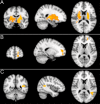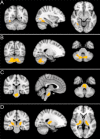Regional cerebral blood flow and FDG uptake in asymptomatic HIV-1 men
- PMID: 22496057
- PMCID: PMC6869962
- DOI: 10.1002/hbm.22078
Regional cerebral blood flow and FDG uptake in asymptomatic HIV-1 men
Abstract
Despite advances in the treatment of patients with human immunodeficiency virus (HIV), HIV-associated neurocognitive disorder occurs in 15-50% of HIV-infected individuals, and may become more apparent as ageing advances. In the present study we investigated regional cerebral blood flow (rCBF) and regional cerebral metabolic rate of glucose uptake (rCMRglc) in medically and psychiatrically stable HIV-1-infected participants in two age-groups. Positron emission tomography (PET) and magnetic resonance imaging (MRI)-based arterial spin labeling (ASL) were used to measure rCMRglc and rCBF, respectively, in 35 HIV-infected participants and 37 HIV-negative matched controls. All participants were currently asymptomatic with undetectable HIV-1 viral loads, without medical or psychiatric comorbidity, alcohol or substance misuse, stable on medication for at least 6 months before enrolment in the study. We found significant age effects on both ASL and PET with reduced rCBF and rCMRglc in related frontal brain regions, and consistent, although small, reductions in rCBF and rCMRglc in the anterior cingulate cortex (ACC) in HIV, a finding of potential clinical significance. There was no significant interaction between HIV status and the ageing process, and no significant HIV-related changes elsewhere in the brain on PET or ASL. This is the first paper to combine evidence from ASL and PET method in HIV participants. These finding provide evidence of crossvalidity between the two techniques, both in ageing and a clinical condition (HIV).
Keywords: ASL; HIV; PET; ageing; glucose uptake; rCBF.
Copyright © 2012 Wiley Periodicals, Inc.
Figures






Similar articles
-
Simultaneous arterial spin labeling functional MRI and fluorodeoxyglucose PET in mild chronic traumatic brain injury.J Neuroradiol. 2024 Sep;51(5):101211. doi: 10.1016/j.neurad.2024.101211. Epub 2024 Jun 20. J Neuroradiol. 2024. PMID: 38908545
-
Mapping the brain in younger and older asymptomatic HIV-1 men: frontal volume changes in the absence of other cortical or diffusion tensor abnormalities.Cortex. 2012 Feb;48(2):230-41. doi: 10.1016/j.cortex.2011.03.006. Epub 2011 Mar 15. Cortex. 2012. PMID: 21481856
-
Direct comparison of fluorodeoxyglucose positron emission tomography and arterial spin labeling magnetic resonance imaging in Alzheimer's disease.Alzheimers Dement. 2012 Jan;8(1):51-9. doi: 10.1016/j.jalz.2011.06.003. Epub 2011 Oct 21. Alzheimers Dement. 2012. PMID: 22018493 Free PMC article.
-
Neuroimaging in cerebrovascular disorders: measurement of cerebral physiology after stroke and assessment of stroke recovery.Semin Nucl Med. 2003 Jan;33(1):56-76. doi: 10.1053/snuc.2003.127293. Semin Nucl Med. 2003. PMID: 12605357 Review.
-
Brain PET and functional MRI: why simultaneously using hybrid PET/MR systems?Q J Nucl Med Mol Imaging. 2017 Dec;61(4):345-359. doi: 10.23736/S1824-4785.17.03008-4. Epub 2017 Jul 27. Q J Nucl Med Mol Imaging. 2017. PMID: 28750494 Review.
Cited by
-
A combined study of 18F-FDG PET-CT and fMRI for assessing resting cerebral function in patients with major depressive disorder.Exp Ther Med. 2018 Sep;16(3):1873-1881. doi: 10.3892/etm.2018.6434. Epub 2018 Jul 9. Exp Ther Med. 2018. PMID: 30186413 Free PMC article.
-
Higher subcortical and white matter cerebral blood flow in perinatally HIV-infected children.Medicine (Baltimore). 2017 Feb;96(7):e5891. doi: 10.1097/MD.0000000000005891. Medicine (Baltimore). 2017. PMID: 28207506 Free PMC article.
-
Neurobehavioral Abnormalities in the HIV-1 Transgenic Rat Do Not Correspond to Neuronal Hypometabolism on 18F-FDG-PET.PLoS One. 2016 Mar 24;11(3):e0152265. doi: 10.1371/journal.pone.0152265. eCollection 2016. PLoS One. 2016. PMID: 27010205 Free PMC article.
-
Resting-state connectivity and spontaneous activity of ventromedial prefrontal cortex predict depressive symptomology and peripheral inflammation in HIV.J Neurovirol. 2018 Oct;24(5):616-628. doi: 10.1007/s13365-018-0658-9. Epub 2018 Jul 18. J Neurovirol. 2018. PMID: 30022427 Free PMC article.
-
Alcohol Use Disorder and Its Comorbidity With HIV Infection Disrupts Anterior Cingulate Cortex Functional Connectivity.Biol Psychiatry Cogn Neurosci Neuroimaging. 2022 Nov;7(11):1127-1136. doi: 10.1016/j.bpsc.2020.11.012. Epub 2020 Nov 28. Biol Psychiatry Cogn Neurosci Neuroimaging. 2022. PMID: 33558196 Free PMC article.
References
-
- American Psychiatric Association (1994):Diagnostic and Statistical Manual of Mental Disorders, 4th ed (DSM‐IV).Washington, DC:American Psychiatric Association.
-
- Ances BM, Roc AC, Wang J, Korczykowski M, Okawa J, Stern J, Kim J, Wolf R, Lawler K, Kolson DL, Detre JA (2006): Caudate blood flow and volume are reduced in HIV+ neurocognitively impaired patients. Neurology 66:862–866. - PubMed
-
- Beck AT, Steer RA (1987): Beck Depression Inventory Manual, The Psychological Corporation, Harcourt Brace Jovanovich Inc., San Antonio.
-
- Beck AT, Steer RA (1990):Beck Anxiety Inventory.San Antonio, TX:The Psychological Corporation.
Publication types
MeSH terms
Substances
LinkOut - more resources
Full Text Sources
Other Literature Sources
Medical

